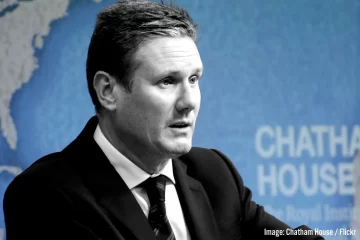With the primary elections for Democratic and Republican presidential candidates well underway, one candidate in particular has been a favoured subject of global news media. Most news sites cover business mogul Donald Trump’s campaign as if he has already won the Republican Party’s nomination for President. Indeed, the results of the GOP primaries suggest an overwhelming likelihood of Trump gaining the nomination. In light of this, it is necessary to discuss precisely who Trump is and what he stands for.
Sexist, racist, and anti-gay are among the adjectives that have been ascribed to him. Trump has established himself as the anti-immigration candidate. He has declared his support for building a wall along the Mexican border and having the Mexican Government pay for it. Trump bizarrely claims that the Mexican Government has cunningly sent all of its criminals and drug dealers to the US along with those from other Latin and South American countries. A closer look at the economic and political situation in Mexico reveals that this is not the case. Several studies have looked into the question of “who crosses the border” and the conclusions show poor, malnourished people; who often die before they reach the US because of their poor health.
Trump has also targeted Muslims. He would not only refuse more refugees into the US, but would also deport Muslims currently living in the US. Islamophobia has been a disease spread around the United States since 9/11 and Trump has brought it back to the forefront. Trump says he will take a stand against ISIS, but offers no solution or proposal of action. In light of last year’s attacks on Paris and the recent attacks on Brussels, all of the prospective presidential candidates have been asked how they would handle a similar situation in the US. The day of the attacks on Brussels, Trump stated in a phone interview that he would be in favour of waterboarding those captured to force information out of them. He went so far as to say more extreme torture would be preferable.
These examples are just a few of the horrendous positions that Donald Trump has taken up since starting his campaign for the Republican nomination. This has resulted in him recently being described as the most disliked politician in the United States. If it is fair to compare, a recent poll has shown he is more disliked than Congress. CNN recently published an article showing how both Trump and Clinton have historic unfavourable ratings. The hostility towards these figures can also be shown by angry protests and heckling at their events.
Trump’s Programme – ‘Making America Great Again’
Trump’s programme is focused on winning over people who, due to the capitalist crisis and the weakened position of US imperialism, are facing serious insecurity and instability. A combination of falling living standards and a crisis of ‘social mobility’ has created a deep-rooted disillusionment and anger amongst a growing layer . These were the people who believed in the American dream, a dream which has now been shattered into a thousand pieces. This is compounded by their understanding that America’s place in the world is not what it once was. Amongst this stratum there is a deep yearning to return to romanticised and fictionalised ‘good old days’. One can understand why the slogan “make America great again” appeals to these layers.
Because of this, Trump’s programme can best be described as right-wing demagoguery. Rather than try and come across as a serious, responsible bourgeois politician – a Clinton or an Obama, even a Bush – Trump says what he likes, scapegoating immigrants and making bold, populist claims to lower taxes, restore industry, claim back America’s prestige from the growing power of China. Trump’s speeches and interviews are made up of a few key target words that he repeats in almost every sentence. One can easily see why these statements have gained an echo, but when subjected to serious analysis they are shown to be utopian at best and deeply reactionary at worst.
One of Trump’s policy proposals concerns opening trade relations with China and reindustrializing America. Trump promises to force China to the bargaining table and open their markets to American companies. The programme claims that Trump will make China “join the 21st century” in terms of improving working standards and decreasing environmental damage. To reindustrialize the US he plans to lower corporate tax to 15% so that companies will move jobs back to America. This will mostly affect larger businesses because the lowest level of this tax is already at 15%, whilst the highest is 39%. Lastly, to secure this arrangement, Trump would deploy the military to the East and South China Sea to prevent Chinese trying to shore up their sphere of economic influence in their backyard.
This plan relies on Trump’s ability to force China and both Chinese and US corporations to do as he wishes. But American industries moved to China to exploit the country’s large, cheap workforce and to avoid expensive domestic environmental regulatory standards. If these companies are forced out of China – something Trump, even if he won the presidency, would not have the power to do – they would only go to India or another developing country, possibly in Africa, where Chinese imperialism is itself very active in exploiting cheap labour. Furthermore, many American corporations profit from the protectionism of the Chinese government. Their goods are made using cheap Chinese labour and then sold to Americans. Trump’s arrogant approach would only lead to discontent between China and the US, driving up tensions and failing to bring jobs back to the US. This is fundamentally because as long as capitalism dominates, capitalists will make decisions on the basis of what will ensure maximum profits, questions of patriotism or the welfare of people who rely on these companies for jobs are always secondary.
Immigration
Trump’s position on border control masquerades as a pro-worker position when in fact it is the opposite. It has its roots in the idea that foreign workers, especially Mexicans, are undermining the pay of US citizens by being willing to accept worse pay and conditions. Blaming Mexican workers for this does not contain even a shred of a solution to the problems faced by US workers because all it does is divide workers amongst themselves. The real enemy, and the one that Trump really represents, is the capitalist class who deliberately turn workers against each other so as to exploit them as much as possible.
As the migrant crisis in Europe shows, migration will happen regardless of the difficulties caused by dangerous seas patrolled by murderous coastguards, because conditions are so bad in home countries of the migrants. But by forcing them into an illegal existence, they are deprived of all possibility of even the limited protections of a capitalist legal system. This makes them easier for bosses to exploit, and drives down wages of US workers. Trump, who himself employs cheap Mexican labour, knows this well.
Tax
Trump’s tax reform programme aims to win people over by giving middle income families money back from their taxes. By raising the minimum tax threshold to $25,000 p/a for single people and $50,000 for married couples, Trump aims to improve the living standards of the ‘squeezed middle’ who earn between his new cut-off figures and current thresholds. On average, he estimates that each family will get back $1,000 more each year. Instead of an extensive tax filing system, he also has proposed a simple one page tax form to eliminate stress.
But these proposals do not actually tackle any of the fundamental problems faced by the American working class. Whilst lowering taxes on the poorest seems like a step forward, in reality families who are currently in the lowest tax bracket already receive all of their taxes back, and yet still face enormous financial difficulties. Trump does not plan to increase the minimum wage to a real living wage, a measure that would actually go some way to solving the problems of ordinary working class people in America. Trump has also pledged to close tax loopholes for the rich, a policy that would be welcomed by many working class people, but one which most people will estimate the billionaire Trump is almost certainly never going to carry out.
In any case, ultimately the problems of inequality stem, not from a skewed tax system, but from an economic system based on private property. No amount of redistribution of income can solve this issue – what is needed is redistribution of ownership of the means of production. Businesses must be taken out of the hands of wealthy individuals and put into the hands of society as a whole so that the economy can be run democratically for need, not profit. This is the only way to solve inequality and help the ‘squeezed middle’ and yet this is a policy that Trump, the billionaire businessman and representative of capitalism, would never even contemplate.
Business and Industry
In terms of businesses tax, Trump claims that under his proposals no business “from a Fortune 500… to a freelancer living job to job” will pay more than 15% in taxes. Trump argues that businesses are leaving the US because of the tax rates and yearns for the 1980s when they had the lowest corporate tax rates in the industrialized world.
But this is only one side of the story. As well as high taxes – which, as we know only too well, can be dodged by those wealthy enough to afford a bit of creative accounting – businesses have failed to invest in the US because of the comparatively high wages received by US workers compared to those in China and south-east Asia where the protection won by the labour movement for workers is much weaker. In a global capitalist economy, the only way to encourage businesses to invest in the US is by winning the ‘race to the bottom’ against these countries: The abolition of the minimum wage, all workplace protections, and restrictions on child labour – at least to begin with.
Furthermore, the world is in the grip of a massive crisis of overproduction, as demonstrated by the dumping of Chinese steel and OPEC oil on the world markets. This is a crisis that, to varying degrees, has gripped every sphere of industry around the world. This is the primary reason why capitalists are unwilling to invest anywhere, let alone the USA. What serious business owner would invest in production when the market is already saturated? Capitalism is faced with the insoluble contradiction today of needing the working class to spend more on consumption, whilst at the same time needing to sack workers and reduce their wages to boost profits. Trump, like all the other representatives of his class, has no solution to this problem.
A shift to the right?
There has been some panic amongst some on the left who interpret the support behind Trump as a shift to the right in American society. But such an interpretation takes this support completely out of context. As we have argued, Trump’s popularity is based principally on his radical façade. Up to a certain point, this represents the unrealised potential for a shift to the left amongst a section of the working class who are currently backing him. It is significant that the majority of Trump supporters put Sanders as their second preference out of the cross-party selection of primary candidates. A Trump government, which could not even begin to alleviate the problems faced by this layer, would only act as a catalyst for this transformation.
Donald Trump’s rally in Chicago, Illinois was disrupted by protesters and had to be cancelled. Altercations between protesters, Trump supporters, and security were reported. Whilst Trump has said in interviews that he does not condone violence or encourage it from his supporters, reports of so-called “Trump militias” and Trump’s promise to “pay the legal fees” of anyone arrested for attacking protesters tells a more sinister story.
This, combined with Trump’s racism and scapegoating of immigrants, has led some on the left to argue that Trump is a fascist. Yet the conditions for the development of genuinely fascist tendencies do not exist at present. Fascism in its classical form is a mass movement based on the middle classes who see no other way out from the crisis beyond the destruction of the labour movement – the trade unions and the workers’ organisations – which they see as responsible for crisis and instability. The class struggle in the USA has not yet reached the level where fascism is on the agenda – and even as society does become more polarised, fascism lacks a strong social base because of the gradual withering away of the middle class and its proletarianisation over the last decades. The potential for a move to the radical left in the USA today is much greater than the potential for a shift to the hard right at this stage.
In fact, last month in Arizona, immigrants’ rights protesters shut down a road outside of Trump’s rally. Another demonstration was recently held in New York City, supported by several activist groups, which marched to Trump Tower on Fifth Avenue carrying placards adorned with slogans protesting Trump’s anti-immigration, sexist, racist, and anti-gay statements and agenda.
What this opposition shows is that a section of the US working class refuse to tolerate Trump and what he stands for. Not only that, but they have reached a very radical conclusion: that Trump’s disgusting ideology must not only be fought with words and ballot boxes, but on the streets. These successes are a vital lesson for the working class and will only embolden them.
One only has to imagine what would happen to a Trump government, which would be attacking its already slim social base with worsening austerity. Given this situation, pregnant with revolutionary implications, Trump would be unlikely to survive his first term.
One Solution – Revolution!
Across Europe there has been a sharp polarization to both ends of the political spectrum, with a rise in left wing and right wing parties. The same can be seen happening in America. Trump says what he thinks, despite the consequences. Everyday CNN’s headline features a new ridiculous quote by Trump. Recently Trump’s comments against abortion and the need to punish women who have them (if it is banned) could be found on every major news channel. Statements like these appeal to a layer of Americans who hold extremely socially and culturally backward ideas.
Yet as in Russia before 1917, the disenfranchisement and poverty from which these backward ideas take root also constitute a revolutionary powder keg. Whilst this layer of people may be partly attracted to Trump because he is socially right-wing, the main attraction is his radicalism. Despite the reality, he has the outwards appearance of an anti-establishment figure. By running on his own money, he gives the impression of being free from corrupting influences. He refuses to be censored. Trump is seen as anti-establishment, a straight shooter, and, somewhat paradoxically for a big businessman, willing to stand up to big business and Wall Street. The masses are tired of the status-quo. From Greece to Britain to Brazil, the working class is tired of being lied to and taken advantage of by their governments. It is for this reason that many of his supporters are attracted to him.
Whilst Trump gathers support on the right, a more clearly radical and progressive force is massing to the left. The emergence of the Bernie Sanders movement represents a historical watershed in US politics. It marks the transformation of outrage and anti-establishment sentiment, the burning anger that has simmered under the surface for the US workers and youth for some time, into a generalized movement against the establishment. Millions have been attracted to Sanders’ call for a “political revolution against the billionaire class”.
As with Trump, Sanders’ support is conditional on him carrying out his programme. Free education, healthcare, welfare, reindustrialisation, the living wage, equality, tackling climate change – all these things are possible, but only on the basis of the expropriation of the capitalists. Only by taking back the immense wealth that these parasites have stolen from working people can we create a decent and fair society. Sanders must adopt this programme.
The slogan of ‘Bernie or bust’ reflects the confidence of the youth. Sanders must capitalize on this by breaking with the Democrats, who would never allow expropriations and genuine socialist policies, and taking his supporters and campaign money with him to build a mass socialist party of the working class. This would constitute the greatest step forward for the American left since the overthrow of slavery, and would pave the way for a socialist revolution. Such developments in the ‘belly of the beast’ would be an inspiration to workers all over the world and would serve as a prelude to the world revolution. This would consign Trump, Clinton, Cruz and all rest to the stuff of stories to frighten children.
by Danielle Anderson and Mordecai Levi
See also: What Trump is and how to fight him



